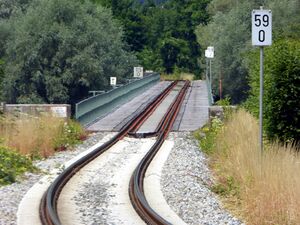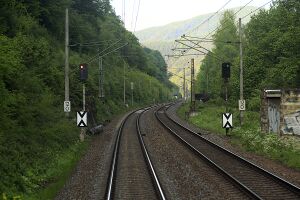Dev:Border between infrastructure managers and countries: Difference between revisions
| [checked revision] | [checked revision] |
(wording) |
(wording) |
||
| Line 3: | Line 3: | ||
Border between infrastructure managers (handover point) is the point where legal responsibility changes between the infrastructure managers [TAF TAP TSI]<ref>{{external|http://taf-jsg.info/wp-content/uploads/2023/07/20230426-JGS-Handbook-3.3-with-XSD-3.3.0.0.pdf|TAP TSI and TAF TSI Sector Handbook for the Communication between Railway Undertakings and Infrastructure Managers (RU/IM Telematics Sector Handbook) Submitted on 20th October 2022}}</ref>. | Border between infrastructure managers (handover point) is the point where legal responsibility changes between the infrastructure managers [TAF TAP TSI]<ref>{{external|http://taf-jsg.info/wp-content/uploads/2023/07/20230426-JGS-Handbook-3.3-with-XSD-3.3.0.0.pdf|TAP TSI and TAF TSI Sector Handbook for the Communication between Railway Undertakings and Infrastructure Managers (RU/IM Telematics Sector Handbook) Submitted on 20th October 2022}}</ref>. | ||
These IM borders can be found between countries and within one e.g. in case there are private and national railway infrastructure managers in a country. Sometimes there | These IM borders can be found between countries and within one e.g. in case there are private and national railway infrastructure managers in a country. Sometimes there two railway lines meet each other. | ||
There are | There are some approaches to represent border between infrastructure managers in railML2 e.g. with one or two tracks. This is due to the reasoning that every track should be considered a separate system with its own properties defined. Being syntactically and semantically valid, they just came from two different users of {{rml|2}}. | ||
When choosing approach with two tracks be aware of semantic constraints e.g. IS:003 "If two <track>s are connected, the @absPos values of the connected {{tag|IS|trackBegin}} and {{tag|IS|trackEnd}} must be identical" <ref name="semCon">[[Dev:Semantic_Constraints]]</ref>. | |||
== Example with two tracks == | == Example with two tracks == | ||
The photo | The photo shows an example of a ‘handover point’ at the Germany-Austria border. In the source code, shown below, there are two tracks managed two IMs {{wikipedia|ÖBB Infra}} in Austria and {{wikipedia|1=DB InfraGO|3=de}} in Germany. Ownership is represented by {{tag|IS|ownerChange}} elements. Each of them have {{tag|IS|ownerChange}} positioned at the beginning of a track. | ||
Further information about IMs is given in the {{tag|CO|infrastructureManager}} element and corresponding {{site|1=https://wiki2.railml.org/wiki/Dev:InfrastructureManagers|2=code list}}. | Further information about IMs is given in the {{tag|CO|infrastructureManager}} element and corresponding {{site|1=https://wiki2.railml.org/wiki/Dev:InfrastructureManagers|2=code list}}. | ||
Here also two railway lines meet each other. Therefore restriction IS:003<ref name="semCon"></ref> cannot be fulfilled because tracks belong to different mileage systems. This is | Here also two railway lines meet each other. Therefore restriction IS:003<ref name="semCon"></ref> cannot be fulfilled because tracks belong to different mileage systems. This is justified via two railway lines referring to tracks. | ||
[[File:Grenzbrücke_Braunau_Simbach.jpg|thumb|Border between infrastructure managers {{wikipedia|ÖBB Infra}} in Austria and {{wikipedia|1=DB InfraGO|3=de}} in Germany ({{external|https://commons.wikimedia.org/wiki/User:Renardo_la_vulpo|By Renardo la vulpo|mode=silent}}/{{external|https://commons.wikimedia.org/wiki/File:Braunau_a_I,_Eisenbahnbr%C3%BCcke_nach_Simbach,_2.jpeg|Image source|mode=silent}}/{{external|https://creativecommons.org/public-domain/cc0/|CC0|mode=silent}})]] | [[File:Grenzbrücke_Braunau_Simbach.jpg|thumb|Border between infrastructure managers {{wikipedia|ÖBB Infra}} in Austria and {{wikipedia|1=DB InfraGO|3=de}} in Germany ({{external|https://commons.wikimedia.org/wiki/User:Renardo_la_vulpo|By Renardo la vulpo|mode=silent}}/{{external|https://commons.wikimedia.org/wiki/File:Braunau_a_I,_Eisenbahnbr%C3%BCcke_nach_Simbach,_2.jpeg|Image source|mode=silent}}/{{external|https://creativecommons.org/public-domain/cc0/|CC0|mode=silent}})]] | ||
| Line 64: | Line 64: | ||
Technically one track is also enough because there is no need for the second track to represent change. See example of one track representing a "Border between infrastructure managers" below. | Technically one track is also enough because there is no need for the second track to represent change. See example of one track representing a "Border between infrastructure managers" below. | ||
The photo | The photo shows an example of a ‘handover point’ at the Germany-Czech Republic border on {{wikipedia|Děčín–Dresden-Neustadt_railway}}. This line is operated by two different rail operating companies, {{wikipedia|Správa_železnic}} in the Czech Republic and {{wikipedia|1=DB InfraGO|3=de}} in Germany, meaning there is a change in infrastructure managers. Mileage of the border was obtained from <ref>{{external|1=https://via.bahnkonzept.de/index.php?srs=6240&dbi=1101&fti=11110000&vsi=010|2=Variabler Infrastruktur Aggregator|mode=silent}}</ref>. | ||
[[File:2023-11-29 railML handoverPoint.jpg|thumb|Border between infrastructure managers {{wikipedia|Správa_železnic}} in the Czech Republic and {{wikipedia|1=DB InfraGO|3=de}} in Germany ({{external|https://de.wikipedia.org/wiki/Benutzer:Falk2|By Falk2|mode=silent}}/{{external|https://commons.wikimedia.org/wiki/File:J35_445_Bf_Schöna,_Einfvsig_V1,_V3.jpg|Image source|mode=silent}}/{{external|https://creativecommons.org/licenses/by-sa/3.0/de/legalcode|CC BY-SA 3.0|mode=silent}})]] | [[File:2023-11-29 railML handoverPoint.jpg|thumb|Border between infrastructure managers {{wikipedia|Správa_železnic}} in the Czech Republic and {{wikipedia|1=DB InfraGO|3=de}} in Germany ({{external|https://de.wikipedia.org/wiki/Benutzer:Falk2|By Falk2|mode=silent}}/{{external|https://commons.wikimedia.org/wiki/File:J35_445_Bf_Schöna,_Einfvsig_V1,_V3.jpg|Image source|mode=silent}}/{{external|https://creativecommons.org/licenses/by-sa/3.0/de/legalcode|CC BY-SA 3.0|mode=silent}})]] | ||
Revision as of 16:21, 23 April 2024
Introduction
Border between infrastructure managers (handover point) is the point where legal responsibility changes between the infrastructure managers [TAF TAP TSI][1].
These IM borders can be found between countries and within one e.g. in case there are private and national railway infrastructure managers in a country. Sometimes there two railway lines meet each other.
There are some approaches to represent border between infrastructure managers in railML2 e.g. with one or two tracks. This is due to the reasoning that every track should be considered a separate system with its own properties defined. Being syntactically and semantically valid, they just came from two different users of railML® 2.
When choosing approach with two tracks be aware of semantic constraints e.g. IS:003 "If two <track>s are connected, the @absPos values of the connected <trackBegin> and <trackEnd> must be identical" [2].
Example with two tracks
The photo shows an example of a ‘handover point’ at the Germany-Austria border. In the source code, shown below, there are two tracks managed two IMs ÖBB Infra (![]() ) in Austria and DB InfraGO (
) in Austria and DB InfraGO (![]() 🇩🇪) in Germany. Ownership is represented by <ownerChange> elements. Each of them have <ownerChange> positioned at the beginning of a track.
🇩🇪) in Germany. Ownership is represented by <ownerChange> elements. Each of them have <ownerChange> positioned at the beginning of a track.
Further information about IMs is given in the <infrastructureManager> element and corresponding code list (link to the railML® website).
Here also two railway lines meet each other. Therefore restriction IS:003[2] cannot be fulfilled because tracks belong to different mileage systems. This is justified via two railway lines referring to tracks.

<metadata>
<organizationalUnits>
<infrastructureManager id="ima01" code="DBN"/>
<infrastructureManager id="ima02" code="ÖBB"/>
</organizationalUnits>
</metadata>
..
<track id="tr01">
<trackTopology>
<trackBegin id="tb01" pos="0" absPos="0">..</trackBegin>
<trackEnd id="te01" pos="59" absPos="59">..</trackEnd>
</trackTopology>
<trackElements>
..
<ownerChange id="och01" pos="0" absPos="0" infrastructureManagerRef="ima01"/>
..
</trackElements>
</track>
<track id="tr02">
<trackTopology>
<trackBegin id="tb02" pos="0" absPos="115">..</trackBegin>
<trackEnd id="te02" pos="30" absPos="85">..</trackEnd>
</trackTopology>
<trackElements>
..
<ownerChange id="och02" pos="0" absPos="115" infrastructureManagerRef="ima02"/>
..
</trackElements>
</track>
<trackGroups>
<line id="lin01" infrastructureManagerRef="ima01" name="Bahnstrecke München–Simbach">
<trackRef ref="tr01"/>
</line>
<line id="lin02" infrastructureManagerRef="ima02" name="Bahnstrecke Neumarkt-Kallham–Braunau">
<trackRef ref="tr02"/>
</line>
</trackGroups>
Example with one track
Technically one track is also enough because there is no need for the second track to represent change. See example of one track representing a "Border between infrastructure managers" below.
The photo shows an example of a ‘handover point’ at the Germany-Czech Republic border on Děčín–Dresden-Neustadt_railway (![]() ). This line is operated by two different rail operating companies, Správa_železnic (
). This line is operated by two different rail operating companies, Správa_železnic (![]() ) in the Czech Republic and DB InfraGO (
) in the Czech Republic and DB InfraGO (![]() 🇩🇪) in Germany, meaning there is a change in infrastructure managers. Mileage of the border was obtained from [3].
🇩🇪) in Germany, meaning there is a change in infrastructure managers. Mileage of the border was obtained from [3].

<metadata>
<organizationalUnits>
<infrastructureManager id="ima01" code="DBN"/>
<infrastructureManager id="ima02" code="SZD"/>
</organizationalUnits>
</metadata>
..
<track id="tr01">
<trackTopology>
<trackBegin id="tb01" pos="0" absPos="0">..</trackBegin>
<trackEnd id="te01" pos="50000" absPos="50000">..</trackEnd>
</trackTopology>
<trackElements>
..
<ownerChange id="och01" pos="0" absPos="0" infrastructureManagerRef="ima01"/>
<ownerChange id="och02" pos="11859" absPos="11859" infrastructureManagerRef="ima02" name="Bahnverw.grenze Bad Schandau Gr"/>
..
</trackElements>
</track>